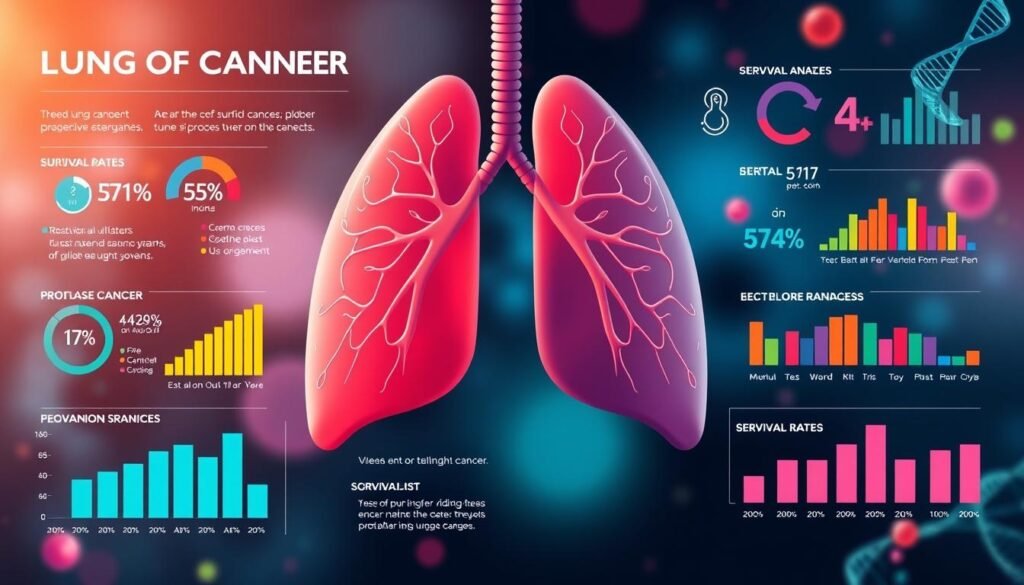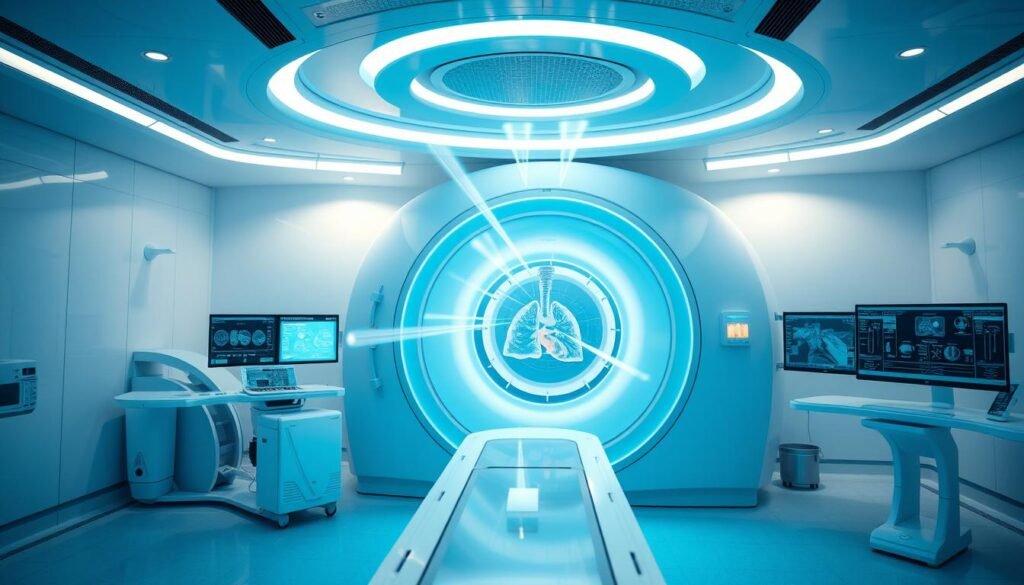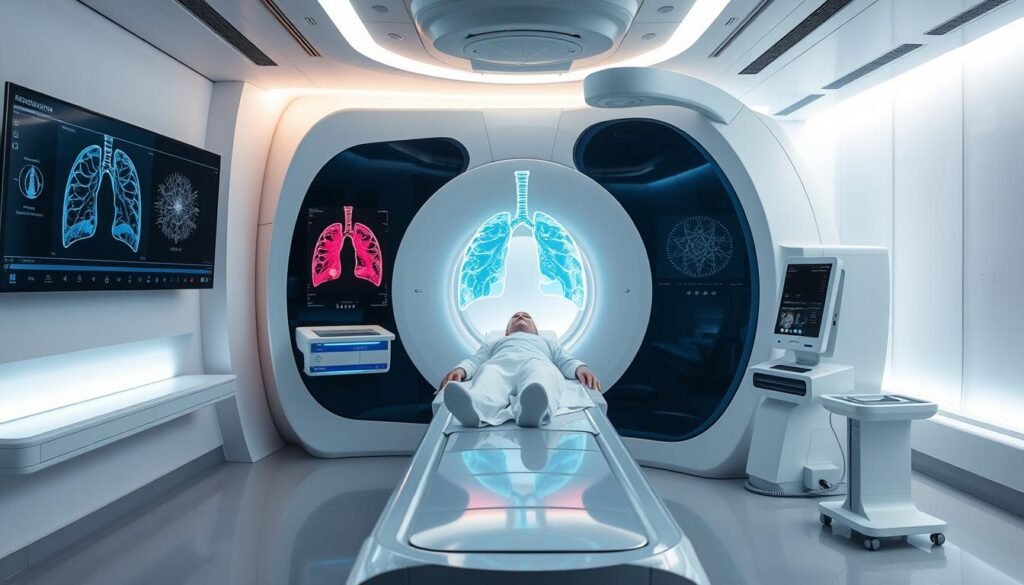Lung cancer is the top cause of cancer-related deaths globally. It takes more lives than breast, prostate, and colorectal cancers combined. This fact shows a clear need for better radiation therapy methods for lung cancer. Previously seen as unbeatable, recent progress in treatments has greatly improved patient survival rates.
Now, nearly 40-50% of patients with advanced lung cancer survive thanks to radiotherapy. This is when it’s used with chemotherapy and immunotherapy. This shows how important advanced radiation technologies are.
Doctors are now using new techniques and tools to fight lung cancer better. These advancements help target the cancer more precisely. They also reduce harm to healthy tissues. This article looks at these game-changing innovations in radiation therapy. They offer not only improved treatments but also hope for those facing this tough diagnosis.
Key Takeaways
- Worldwide and in the US, lung cancer remains the leading cause of cancer-related deaths.
- Recent radiotherapy advancements have increased cure rates for lung cancer to nearly 40-50% for locally advanced cases.
- Stereotactic ablative radiotherapy (SABR) is becoming the preferred treatment for inoperable patients with limited volume tumors.
- PHASER technology aims to administer radiotherapy treatments in less than one second, enhancing precision.
- Access to radiotherapy remains limited, with around 50% of cancer patients worldwide unable to receive it.
- Recent collaborative efforts have led to significant improvements in manufacturing costs and capabilities of radiotherapy technologies.
- Nanoparticle therapies are being explored to enhance radiation effectiveness against tumor cells.
The Evolution of Radiation Therapy
Radiation therapy for lung cancer has changed greatly over time. At first, it was mainly used to relieve symptoms in late-stage patients. Lung cancer is the top cancer killer, causing 1.6 million deaths a year. This pushed for big improvements in treatment.
Historical Role in Lung Cancer Treatment
In the early days, radiation therapy was key to help those who couldn’t have surgery. It has helped more than half of all lung cancer patients. But, older radiation methods didn’t do well against early-stage cancers. Then, 3D conformal radiation therapy came in the 1990s. It targeted tumors better and saved healthy organs from unnecessary radiation.
Shift Towards Curative Therapies
Now, lung cancer treatment aims more at curing. Techniques like intensity-modulated radiotherapy (IMRT) make treatment fit each patient better. This is good for treating big tumors with less harm. Adding 4DCT and CBCT methods has made radiation therapy even more tailored. They track how tumors move during breathing, improving treatment accuracy.
Understanding Lung Cancer and Its Challenges
Lung cancer is the top cause of cancer-related deaths in the United States. It has a huge impact on individuals and their families. Often, it’s diagnosed too late, making the battle even tougher. The need for early detection and understanding the obstacles is critical in fighting this tough cancer.
The Deadliest Cancer: Statistics and Impact
Each year, around 220,000 people in the U.S. are found to have lung cancer. This leads to about 155,000 deaths annually. Non-small cell lung cancer (NSCLC) makes up 80% to 90% of these cases. Lung adenocarcinoma, the most common type, is 40% of all lung cancers. However, only 20% of patients live more than five years after finding out they have it. This shows how vital it is to improve lung cancer treatment.
Advanced Stages and Treatment Limitations
Late-stage lung cancer brings tough challenges for treatment. Up to 76% of patients see their disease come back or get worse after surgery. Treatments like chemotherapy and targeted therapies help some. But they can also cause tiredness, nausea, and trouble breathing. As treatments get better, understanding these challenges is key to helping patients.

Innovations in Radiation Therapy for Lung Cancer
The field of radiation therapy is rapidly changing. New innovations bring hope to lung cancer patients. These technologies aim to protect healthy tissues while focusing on the tumor. This leads to better outcomes for patients.
New Technologies Transforming Treatment
New methods like FLASH radiation therapy are groundbreaking. This technique delivers radiation fast, saving the healthy tissue around tumors. SABR is now a top choice for small tumors, especially if surgery is not an option. These methods change how we treat lung cancer, focusing on curing and extending lives.
Integration of Genetics and Personalized Medicine
Using genetics in cancer care is a big step forward. It helps doctors create treatments that fit each person’s unique genes. Now, some lung cancer patients see cure rates jump to 40-50% with combined treatments. New machines that mix imaging with radiation also increase treatment accuracy.
Treatment planning has become more automated, making the process faster. With ongoing innovations, treatment for lung cancer adapts to each patient’s needs. This makes it more effective.
| Technologies | Key Benefit | Patient Suitability |
|---|---|---|
| FLASH Radiation Therapy | Minimizes damage to healthy tissue | Advanced and localized tumors |
| Stereotactic Ablative Radiotherapy (SABR) | Preferred for limited volume tumors | Not suitable for surgery candidates |
| Personalized Cancer Treatment | Tailors therapy based on genetics | All lung cancer patients |
| Automation in Planning | Reduces complexity and time | All lung cancer patients |
| Multimodal Machines | Improves precision and dosage | Radio-sensitive tumors |
The focus on personalizing treatment plans is more important than ever. It leads to better survival rates and quality of life for patients.
Stereotactic Body Radiation Therapy (SBRT)
Stereotactic body radiation therapy (SBRT) changes lung cancer treatment with its approach. It gives high-dose radiation in just a few sessions. Usually, treatment is done in one to two weeks. This is quicker than the usual six to eight weeks.
It lets doctors use higher doses while protecting healthy tissues. This is possible because the radiation is very focused.
High-Dose Treatment in Fewer Sessions
SBRT focuses on treating small or moderate-sized tumors effectively. It’s a strong option for patients who can’t undergo surgery. Studies show survival rates of 43% to 95% over three years with SBRT.
Loco-regional control rates can reach up to 98%. This makes SBRT a top pick for treating early-stage non-small cell lung cancer (NSCLC).
Effectiveness Compared to Traditional Approaches
SBRT is recognized as effective compared to conventional radiation therapy. An analysis covering 2005 to 2018 reviewed 1434 patients in nineteen trials. It found SBRT to be as effective for both central and peripheral lung tumors.
Even with high doses, patients generally handle SBRT well. Only 10% to 30% experience severe side effects. This effectiveness and tolerance underline SBRT’s role in modern lung cancer treatments. For more details, check the studies on the effectiveness of SBRT.
Intensity-Modulated Radiation Therapy (IMRT)
Intensity-modulated radiation therapy, or IMRT, is a big step forward in lung cancer treatment. It focuses on precision targeting to make therapy better. Oncologists can finely tune radiation doses with IMRT. They make sure the tumor gets enough treatment while saving nearby healthy tissue. This careful approach boosts the success of cancer treatments.
Precision in Targeting Tumors
IMRT uses advanced technology to treat lung cancer in a custom way. It shapes the radiation beams to match the tumor’s form. This protects the organs and tissues close to it. Precision targeting in IMRT helps a lot with treatment, especially if the tumor is near important chest parts.
Advantages Over Conventional Radiation
IMRT has many benefits over old radiation methods:
- With IMRT, 50% of stage I/II inoperable non-small cell lung cancer (NSCLC) patients see no cancer growth for 2 years.
- In stage III inoperable NSCLC, this “no growth” rate goes up to 58%. This offers new hope for treating late-stage cancer.
- The survival rate looks good too, with 55% for stage I/II and 58% for stage III living at least 2 years.
- Patients in later stages live a median of 25 months, showing how IMRT can help extend lives.
- Only 11% face severe lung issues soon after treatment. The rate of long-term problems is even less, at 4%.
These facts show how IMRT helps patients live better during and after lung cancer treatment. As IMRT improves and spreads, it will change lung cancer care. This means more accuracy and safety for those treated.
Proton Beam Therapy
Proton beam therapy is a big leap forward in treating lung cancer. It uses protons, not the usual X-rays. This new way of radiation therapy means doctors can hit tumors with high doses but keep healthy tissues safe. This technique improves the accuracy of treatment, which could help patients get better results.
How It Works: Principles and Benefits
Proton beam therapy targets tumors with amazing accuracy. Protons unleash their energy right at the tumor, protecting nearby organs. This matters a lot for lung cancer patients. Their esophagus, heart, and spinal cord are close to the cancer. The MD Anderson Proton Therapy Center led the way in using proton therapy with chemotherapy. This combo shows how effective it can be.
If you have lung or thoracic cancer, proton therapy could be great for you. Research says it leads to fewer side effects than old methods. Plus, the chances of staying cancer-free for five years are high. Some treatments reach up to 85% success.
Reducing Damage to Surrounding Tissues
Proton beam therapy is good at protecting healthy tissues. Studies show it’s less harmful than regular radiotherapy. Techniques like pencil-beam scanning make it very precise. This keeps vital organs safe during treatment.
This is crucial for treating advanced lung cancer. When you add chemotherapy to proton therapy, patients often live longer. Many are thankful for proton beam therapy. Some even celebrate years of life after the treatment.

Image-Guided Radiation Therapy (IGRT)
Image-guided radiation therapy (IGRT) changes how we treat cancer. It uses advanced imaging to make radiation more precise. This technology is especially good for tumors near vital organs or ones that move, like in the lungs. By using detailed images, doctors can plan and deliver treatment more accurately, leading to better outcomes for patients.
Enhanced Targeting with Cone Beam CT Scans
Cone beam CT scans make IGRT even more accurate. These scans help locate tumors with great precision. This means radiation hits the tumor, not the healthy tissue around it. So, patients face fewer side effects and may see better treatment results. Cone beam CT scans have significantly improved radiation therapy.
Real-Time Monitoring and Adjustment
IGRT includes real-time dose monitoring to make treatment more effective. It lets doctors adjust treatment instantly based on tumor movement and patient changes. This way, the radiation always targets the right spot. IGRT’s ability to adapt quickly is crucial in cancer care, where accuracy is key.
| Feature | Conventional Radiation Therapy | Image-Guided Radiation Therapy (IGRT) |
|---|---|---|
| Tumor Localization | Limited accuracy | High precision with cone beam CT scans |
| Real-Time Monitoring | Not available | Enabled with real-time dose monitoring |
| Treatment Adaptability | Static treatment plans | Flexible plans adjusting to patient changes |
| Typical Side Effects | Higher risk of affecting healthy tissues | Reduced risk of collateral damage |
Experts at places like Memorial Sloan Kettering are leaders in using IGRT. They’re bringing the latest in cancer fighting to patients. For more info on IGRT and its benefits, check out this resource.
Respiratory Gating Techniques
Dealing with tumor movement during radiation therapy is very important, especially in lung cancer. Respiratory gating techniques are key to solving this. They match the radiation with the patient’s breaths. This helps control tumor movement better. This makes the treatment more precise, which improves how well it works and patient health.
Managing Tumor Movement During Treatment
Lung cancer treatment needs very accurate radiation. But, tumors move when patients breathe. The Real-Time Position Management (RPM) system by Varian Medical Systems tracks this movement in all directions. This means radiation hits the right spot more often. Over 2,700 Horizon™ systems are used in Surface Guided Radiation Therapy (SGRT). This shows many clinics use respiratory gating.
Improving Treatment Precision and Effectiveness
Using respiratory gating in lung cancer treatments has shown good results. It protects normal lung tissue from too much radiation. It has also helped people live longer compared to older methods. Technology has gotten better since the 1990s. Now, doctors can better target tumors at the best times during breathing. This reduces unnecessary radiation around the tumor.

| System | Technology | Benefits |
|---|---|---|
| Varian RPM | Tracks motion in three dimensions | Increases precision and reduces treatment times |
| DYN’R SDX | Spirometer with biofeedback | Improves patient participation in breathing |
| C-RAD Catalyst+ | High-resolution surface imaging | Submillimeter accuracy for real-time management |
Respiratory gating techniques keep making lung cancer treatment better. They are more tailored to each patient, leading to greater success against this tough disease. For more on these advancements, check out this research article.
Personalized Treatment Planning
In the world of lung cancer care, personalized treatment is a big step forward. It means creating special plans for each patient’s needs. Doctors use tech and science to design treatments that match the unique features of someone’s cancer.
Combining Oncology Informatics and Biology
Bringing oncology informatics into treatment planning helps doctors make sense of complex data. With the help of tech like artificial intelligence, they can make smart choices. These AI tools predict outcomes by learning from data and past results.
Customizing Approaches for Individual Patients
Personalized cancer treatments aim to be most effective while cutting down bad side effects. Doctors look at both the shape of a cancer and its biological makeup. They use tech to track tumors and study genetic data to tailor treatments.
Such careful planning leads to better health outcomes. For example, the AI system Deep Profiler designs radiation plans that lower the risk of failure. By understanding a patient’s risks, doctors can boost survival chances and life quality.
Lung Cancer Radiotherapy Advancements
Modern treatments for lung cancer have improved a lot with new strategies. Now, combining radiation with chemotherapy and immunotherapy is key. This approach helps doctors improve the health outcomes of their patients greatly.
Combining Radiation with Chemotherapy and Immunotherapy
Radiation therapy and chemotherapy work together to fight lung cancer from different sides. Studies show that about 77% of lung cancer patients might benefit from radiotherapy. This combination not only tackles the tumor better but also helps people live longer.
Recent Studies and Positive Outcomes
Recent research supports using both therapies together in treating lung cancer. Drugs like Pembrolizumab (Keytruda) and Atezolizumab (Tecentriq) are now approved for use after surgery. They are helpful especially for a certain type of lung cancer called non-small cell lung cancer (NSCLC).
New techniques in radiotherapy, like IMRT and SBRT, target tumors very accurately. This precision helps protect the healthy tissue around the tumor. The results from recent studies stress the importance of continued research. It’s vital for making lung cancer treatments even better.
| Treatment Mode | Effectiveness | Safety Profile | Outcome Improvements |
|---|---|---|---|
| Radiation with Chemotherapy | Increased tumor control | Enhanced tolerability in patients | Improved survival rates |
| Radiation with Immunotherapy | Targets specific cancer characteristics | May reduce systemic toxicity | Active disease management |
| Combination Therapies | Addresses multiple disease pathways | Improved safety profiles with tailored approaches | Holistic treatment effectiveness |
Conclusion
The way we treat lung cancer is changing fast, thanks to big steps forward in advancements in radiation therapy. New methods like Stereotactic Body Radiation Therapy (SBRT) and Intensity-Modulated Radiation Therapy (IMRT) are becoming key in battling non-small cell lung cancer (NSCLC). These techniques are more exact in targeting cancer, leading to better results and possibly longer lives for patients.
They also protect healthy tissues by focusing high doses of radiation right on the tumor. This gives us a peek at the bright future of lung cancer treatment.
Moving from old approaches like 3-dimensional conformal radiation therapy (3DCRT) to newer ones shows our dedication to improving patient lives. Research shows that IMRT lowers the risk of damage to lungs and esophagus. It means radiation therapy is getting better not just at treating cancer but also at making sure patients have a good quality of life.
This is encouraging news for everyone facing lung cancer as care keeps getting better.
In the quest for constant progress, the medical world is exploring and adopting new technologies. The use of advanced imaging like 4D-CT and PET-CT helps doctors plan treatments more accurately. This tackles the issue of tumor movement, making therapy more effective.
All these changes are leading us to a new phase in cancer care. It’s a time filled with hope for those fighting lung cancer.